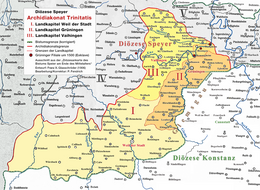Allerheiligenstift (Speyer)


The Allerheiligen- or Dreifaltigkeitsstift (official name Kollegiatstift "St. Trinitatis ac Omnium Sanctorum") was a monastery located in Speyer, the provost of which was included in the diocese administration and headed the Archdeaconate of Trinity, which was mainly located on the right bank of the Rhine . Simultaneously, the pin with the part Domstift , the Monastery of St. German and Moritz , and the Monastery of St. John Guido and the four main parishes of the city of Speyer.
history
Collegiate church
The abbey located within Speyer consisted, among other things, of the abbey church built in the 11th century by Bishop Sigebodo , which was built south of the old gate between the city wall and the older St. Peter's Church . The originally Romanesque collegiate church was about 50 meters long, 25 meters wide and with its Romanesque crossing tower about 35 meters high. Gothic extensions and alterations were added in the 14th century .
In the Palatinate War of Succession , the Allerheiligenstift was destroyed by the fire in Speyer in 1689 and was later rebuilt. It existed for about 100 years until it was auctioned for demolition and demolished after the French Revolution in the course of the French annexation of the areas on the left bank of the Rhine.
Pen tips
A provost (derived from the Latin “praepositus”) did not have to be a cleric in the Middle Ages . He was head of the canons of his respective collegiate foundation and head of the external affairs of a cathedral or collegiate chapter . The cathedral provost and the three provosts belonging to the cathedral chapter of Speyer were also involved in the diocesan administration and enjoyed some pontificals as the bishop's deputy . Because of the double burden of the Speyr bishops as Reich Chancellors in the High Middle Ages, the monasteries were more and more involved in the territorial policy of the bishop and in the chancellery work and had to delegate the archdeaconate administration . By concentrating on “higher tasks”, a number of provosts - including those from the Holy Trinity Foundation - made the career leap to bishop.
In 1233 Konrad von Thann , who was already provost of Allerheiligen at a young age, was appointed Bishop of Speyer.
The 1233 subsequent "C. prepositus sancti Trinitatis Spirensis ”(provost“ C [onrad] ”from the Trinity convent of Speyer) could, according to Zölch, have been Konrad von Eberstein , who in 1237 also succeeded Konrad von Thann as bishop.
In 1329 the provost of the Trinity Monastery of Gerlach von Erbach was elected as Bishop of Worms, which the Pope did not confirm. There was a schism in the diocese of Worms , during which the cleric died a violent death in 1332.
As the successor to David Göler von Ravensburg († 1539) Otto von Waldburg (1514–1573) took over the post of provost. He later rose to become Bishop of Augsburg and Cardinal.
On March 7, 1758, Cathedral Scholaster Karl Joseph von Mirbach was presumably the last provost of the Trinity Monastery, which had long since lost its territorial significance due to the Reformation in Württemberg (from 1534).
reception
Nowadays only the Allerheiligenstrasse reminds of the once important monastery, which was located north of the smithy tower in the area of today's Lindenstrasse. You can find the pen today on the bird's-eye view of the “ Free Imperial City of Speyer before Destruction in 1689” by Philipp Stürmer (1916–1998) in the Palatinate History Museum . The Allerheiligenstift is still a motif for commemorative coins and is mentioned in city tours.
literature
- Hans Ammerich : The diocese of Speyer and its history. Six volumes. Sadifa Media, Kehl am Rhein 1998–2003.
- Franz Xaver Remling : History of the Bishops of Speyer , Volume 2. Mainz 1854. Digital scan
- Karl-Albert Zölch: The bishops of Speyer at the time of Emperor Friedrich II. (Dissertation at the University of Heidelberg). Heidelberg 2014 PDF
Individual evidence
- ↑ Translated: "Holy Trinity to All Saints"; in medieval sources mostly called Dreifaltigkeitsstift .
- ^ Franz Joseph Mone: History and description of Speyer . Oswald, 1817, p. 92 ( full text in Google book search).
- ↑ It is possible that the Peterskirche previously served as the monastery church.
- ^ Karl-Albert Zölch, The Bishops of Speyer at the time of Emperor Friedrich II, Heidelberg 2014, p. 123 u. 177.
- ^ Karl-Albert Zölch, The Bishops of Speyer at the time of Emperor Friedrich II, Heidelberg 2014, p. 155 u. 178.
- ^ Konrad von Busch and Franz Xaver Glasschröder : Choir Rule and Younger Sea Book of the Old Speyer Cathedral Chapter , Speyer, Historischer Verein der Pfalz, 1923, page 201
- ^ Franz Xaver Remling : History of the Bishops of Speyer , Volume 2, Mainz, 1854, page 667; Digital scan
- ^ Museum SchPIRA - "Medieval city map of Speyer" (Overview) (museum-digital). In: museum-digital.de. Retrieved February 3, 2017 .
- ^ Numismatic Society Speyer eV
- ↑ Speyer, Kaiser, Kunst und Kirchen (PDF; 575 kB)
Coordinates: 49 ° 18 ′ 47.8 " N , 8 ° 26 ′ 13.8" E